
| |
CONFEDERATE PARADE FLAG IN THE "SOUTHERN CROSS" OR "BATTLE FLAG" FORMAT, WITH A UNITED CONFEDERATE VETERAN'S OVERPRINT, AN UNUSUAL EXAMPLE, 1910-1920 |
|
| Available: |
Sold |
| Frame Size (H x L): |
20" x 25" |
| Flag Size (H x L): |
11.5" x 16.75" |
|
| Description....: |
|
CONFEDERATE PARADE FLAG IN THE "SOUTHERN CROSS" OR "BATTLE FLAG" FORMAT, WITH A UNITED CONFEDERATE VETERAN'S OVERPRINT, AN UNUSUAL EXAMPLE, 1910-1920:
Confederate parade flag in the rectangular format of the design most commonly referred to as the "Confederate battle flag" or the "flag of the Army of Northern Virginia", bearing the Southern Cross and 13 stars. Printed on cotton, the flag was afterwards overprinted in black ink with the acronym "U.C.V." in the triangular quadrant above the apex. Few Confederate reunion flags have survived with overprinted text. The overprint adds specific history of use, as well as degrees of both graphic interest and general scarcity. Though the overall design is not unique or particularly elaborate, I have never owned this exact version of a U.C.V. overprinted parade flag, in this size and fabric, which adds greater interest.
The U.C.V., or United Confederate Veterans, wasn't founded until 1889, after it became more acceptable for the aging members of the former Confederate Army to gather together for purposes relating to their former service. Wikipedia probably gives the best, most concise description of the U.C.V. that I have encountered:
"Prior to 1889, Confederate veterans had no national organization similar to the Grand Army of the Republic [the primary veterans' association for the Union Army]. Several separate fraternal and memorial groups existed on a local and regional level. Meeting in New Orleans, Louisiana, in 1889, several of these groups united and formed the United Confederate Veterans Association. The organization was founded to serve as a benevolent, historical, social, and literary association. The UCV was active well into 1940's.
The primary functions of the organization were to provide for widows and orphans of former Confederate soldiers, preserve relics and mementos, care for disabled former soldiers, preserve a record of the service of its members, and organize reunions and fraternal gatherings. At its height, membership in the organization was approximately 160,000 former Confederate soldiers organized into 1,885 local camps. The UCV produced a magazine called Confederate Veteran with articles about events during the war and providing a forum for lost comrades to locate one another."
There were many flag designs associated with secession and almost uncountable variations. Many people are surprised to learn that this particular one, which is by far the most readily identified in modern times, was not the national flag of the Confederate States of America. There were three different national flags over the course of the war, all of which were carried in battle by various units. The first among them, nicknamed the "Stars & Bars", looked quite a bit like the Stars & Stripes. It had a blue canton with between 7 and 11 white stars (officially) and three horizontal stripes or "bars", ordered red-white-red. Because it looked so much like the Stars & Stripes, the Stars & Bars served poorly as a signal for Confederate troops on the battlefield. For this reason, the next two national designs deviated greatly from the first. Each incorporated the Southern Cross as part of its elements. It was Southern Cross by itself, however, that actually came to be called "the battle flag", partly because it was carried for this purpose by Robert E. Lee and his Army of Northern Virginia, and partly because the 2nd and 3rd national designs were not particularly loved by Confederate soldiers.
The 2nd national flag (nicknamed "the Stainless banner") was primarily white, so many felt that it looked too much like a surrender flag. The 3rd national flag was adopted 36 days before the war ended and thus simply wasn't around long enough to win great affection. For these reasons it was the "battle flag" that became the most widely used colors in veteran's reunions, was incorporated into the flags of many southern states, and became engrained as an identifying image of the American South.
Mounting: The solid cheery molding dates to the 2nd half of the 19th century. The flag has been hand-stitched to 100% hemp fabric. Spacers keep the textile away from the glass, which is U.V. protective.
Condition: There are no serious condition issues. |
|
|
|
| Collector Level: |
Beginners and Holiday Gift Giving |
|
| Flag Type: |
Parade flag |
|
| Star Count: |
|
|
| Earliest Date of Origin: |
1910 |
|
| Latest Date of Origin: |
1920 |
|
| State/Affiliation: |
The Confederacy |
|
| War Association: |
1861-1865 Civil War |
|
| Price: |
SOLD |
|
| |
Views: 3902 |
|
|
|

